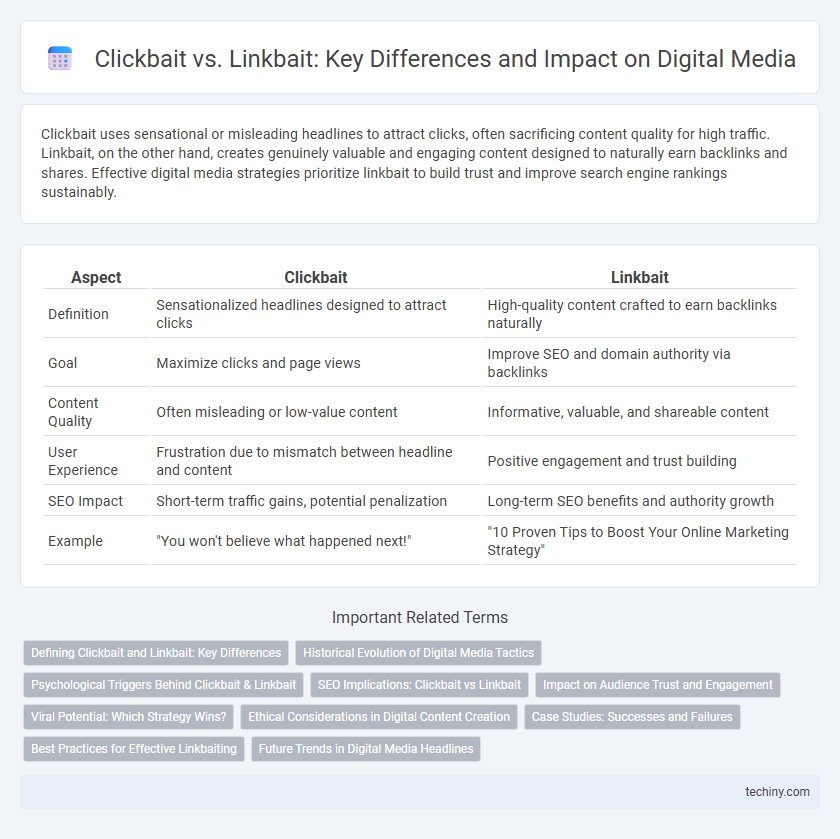Clickbait uses sensational or misleading headlines to attract clicks, often sacrificing content quality for high traffic. Linkbait, on the other hand, creates genuinely valuable and engaging content designed to naturally earn backlinks and shares. Effective digital media strategies prioritize linkbait to build trust and improve search engine rankings sustainably.
Table of Comparison
| Aspect | Clickbait | Linkbait |
|---|---|---|
| Definition | Sensationalized headlines designed to attract clicks | High-quality content crafted to earn backlinks naturally |
| Goal | Maximize clicks and page views | Improve SEO and domain authority via backlinks |
| Content Quality | Often misleading or low-value content | Informative, valuable, and shareable content |
| User Experience | Frustration due to mismatch between headline and content | Positive engagement and trust building |
| SEO Impact | Short-term traffic gains, potential penalization | Long-term SEO benefits and authority growth |
| Example | "You won't believe what happened next!" | "10 Proven Tips to Boost Your Online Marketing Strategy" |
Defining Clickbait and Linkbait: Key Differences
Clickbait uses sensationalized headlines and misleading content to attract clicks, often sacrificing accuracy for viral potential. Linkbait, by contrast, focuses on creating genuinely valuable, high-quality content designed to earn organic backlinks and improve SEO ranking. Understanding these key differences helps digital marketers develop ethical strategies that build trust and long-term engagement.
Historical Evolution of Digital Media Tactics
Clickbait emerged in the early 2000s as sensational headlines designed to maximize clicks and ad revenue, often sacrificing content quality. Linkbait evolved later, prioritizing valuable, shareable content that naturally attracts backlinks and enhances SEO performance. This shift reflects digital media's transition from quantity-driven traffic generation to quality-focused audience engagement and search engine authority.
Psychological Triggers Behind Clickbait & Linkbait
Clickbait exploits psychological triggers such as curiosity gaps, urgency, and emotional arousal to compel users to click on sensationalized headlines often lacking substance. In contrast, linkbait appeals to the desire for social validation and informational value by offering genuinely useful, shareable content that encourages organic engagement. Understanding these psychological mechanisms helps digital marketers craft strategies that balance user interest with content integrity, enhancing both traffic and trust.
SEO Implications: Clickbait vs Linkbait
Clickbait often prioritizes sensational headlines that increase clicks but can harm user trust and SEO rankings due to high bounce rates and low engagement metrics. Linkbait, designed to attract genuine backlinks through valuable, informative content, boosts domain authority and improves search engine visibility. Search engines favor linkbait strategies as they enhance site credibility and sustain organic traffic growth over time.
Impact on Audience Trust and Engagement
Clickbait often diminishes audience trust due to misleading headlines that fail to deliver promised content, leading to higher bounce rates and reduced long-term engagement. In contrast, linkbait provides valuable, relevant information that encourages sharing and fosters loyal readership by aligning user expectations with content quality. Effective digital media strategies prioritize linkbait to build sustainable audience relationships and enhance brand credibility.
Viral Potential: Which Strategy Wins?
Clickbait relies on sensationalized headlines to trigger curiosity and drive clicks, often leading to high initial traffic but lower sustained engagement due to misleading content. Linkbait focuses on creating genuinely valuable and shareable content, encouraging organic linking and long-term virality through trust and relevance. The viral potential of linkbait surpasses clickbait by fostering authentic user interaction and sustainable growth in digital media ecosystems.
Ethical Considerations in Digital Content Creation
Clickbait often relies on misleading headlines that prioritize clicks over truthful content, raising significant ethical concerns about deception and audience manipulation. Linkbait, while also designed to attract attention, typically offers valuable or relevant information that encourages organic sharing, aligning better with ethical standards in digital content creation. Upholding transparency and trust in digital media requires creators to balance engagement strategies with respect for audience integrity.
Case Studies: Successes and Failures
Case studies reveal that clickbait headlines generate high initial click-through rates but often result in low user engagement and trust, as seen in BuzzFeed's early viral content versus its later audience skepticism. Linkbait strategies, exemplified by Moz's comprehensive SEO guides, foster sustained backlinks and increased domain authority by providing valuable, shareable content. Failures in clickbait campaigns, such as Upworthy's backlash for misleading titles, highlight the importance of balancing attention-grabbing elements with content relevance to maintain long-term brand credibility.
Best Practices for Effective Linkbaiting
Effective linkbaiting in digital media centers on creating high-quality, valuable content that naturally attracts genuine engagement and shares. Prioritize relevance and authenticity by addressing audience needs with insightful articles, infographics, or videos rather than relying on sensationalized headlines typical of clickbait. Employ SEO strategies such as keyword optimization and strategic internal linking to enhance visibility while maintaining credibility and user trust.
Future Trends in Digital Media Headlines
Clickbait headlines exploit curiosity gaps with sensational or misleading phrasing to drive immediate clicks but often sacrifice trust and long-term engagement. Linkbait, on the other hand, prioritizes creating genuinely valuable, shareable, and content-rich headlines that foster organic traffic growth and social sharing. Future trends in digital media emphasize a shift toward linkbait strategies, leveraging AI-driven personalization and data analytics to craft authentic, targeted headlines that enhance user experience and brand credibility.
Clickbait vs Linkbait Infographic

 techiny.com
techiny.com